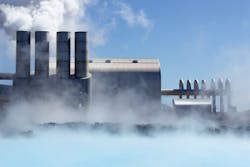DOE’s ‘Earthshots’ Offers $74 Million to Geothermal Energy Pilot Projects
The Department of Energy’s Earthshots Initiative is making available up to $74 million to up to seven pilot projects that the department thinks could help advance the potential of advanced geothermal energy as a greater potential source of renewable energy.
This R&D funding opportunity, part of the 2021 Bipartisan Infrastructure Law, is the DOE’s first for geothermal energy since the launch of the Enhanced Geothermal Shot, part of DOE’s Energy EarthShots Initiative, which seeks to cut the cost of geothermal energy 90% by 2035.
“Advances in enhanced geothermal systems will help introduce geothermal energy in regions where, until recently, the use of this renewable power source was thought to be impossible,” Energy Secretary Jennifer Granholm said. “These pilot demonstrations will help us realize the enormous potential of the heat beneath our feet to deliver clean, renewable energy to millions of Americans.”
Geothermal power has a measured potential of some 90 GW in theoretical power generation, but currently only produces about 3.7 GW in the U.S. According to the DOE, most of that potential cannot be harnessed with the technology that is market ready today.
In addition to power generation, geothermal power could also enable technologies for widespread deployment of geothermal heating and cooling, thereby saving energy.
Tapping the geothermal resource requires a permeable section of earth, heat energy and a fluid medium. While geothermal heat is common underground, the other two elements of permeable space and adequate water are often not available in the same spot.
The DOE’s pilot programs would use human-made underground reservoirs to enable the fluid flow necessary to draw geothermal energy to the surface, where it can be captured to power homes across the country.
Favorable geothermal resources are often located about 4,000 feet underground, under extreme conditions such as high pressure, hot temperatures, abrasive rocks and a corrosive environment – all conditions that are hard on human-made equipment. The DOE’s programs seek to address these challenges through research and development, helping scientists better understand subsurface hazards and allow engineers to design better drilling techniques and energy capture technologies.
Applications for prospective pilot programs will be accepted over multiple rounds. First-round letters of intent are due March 8, 2023, and first-round applications will be due July 7, 2023, according to the DOE.
About the Author
Jeff Postelwait
Managing Editor
Jeff Postelwait is a writer and editor with a background in newspapers and online editing who has been writing about the electric utility industry since 2008. Jeff is senior editor for T&D World magazine and sits on the advisory board of the T&D World Conference and Exhibition. Utility Products, Power Engineering, Powergrid International and Electric Light & Power are some of the other publications in which Jeff's work has been featured. Jeff received his degree in journalism news editing from Oklahoma State University and currently operates out of Oregon.
